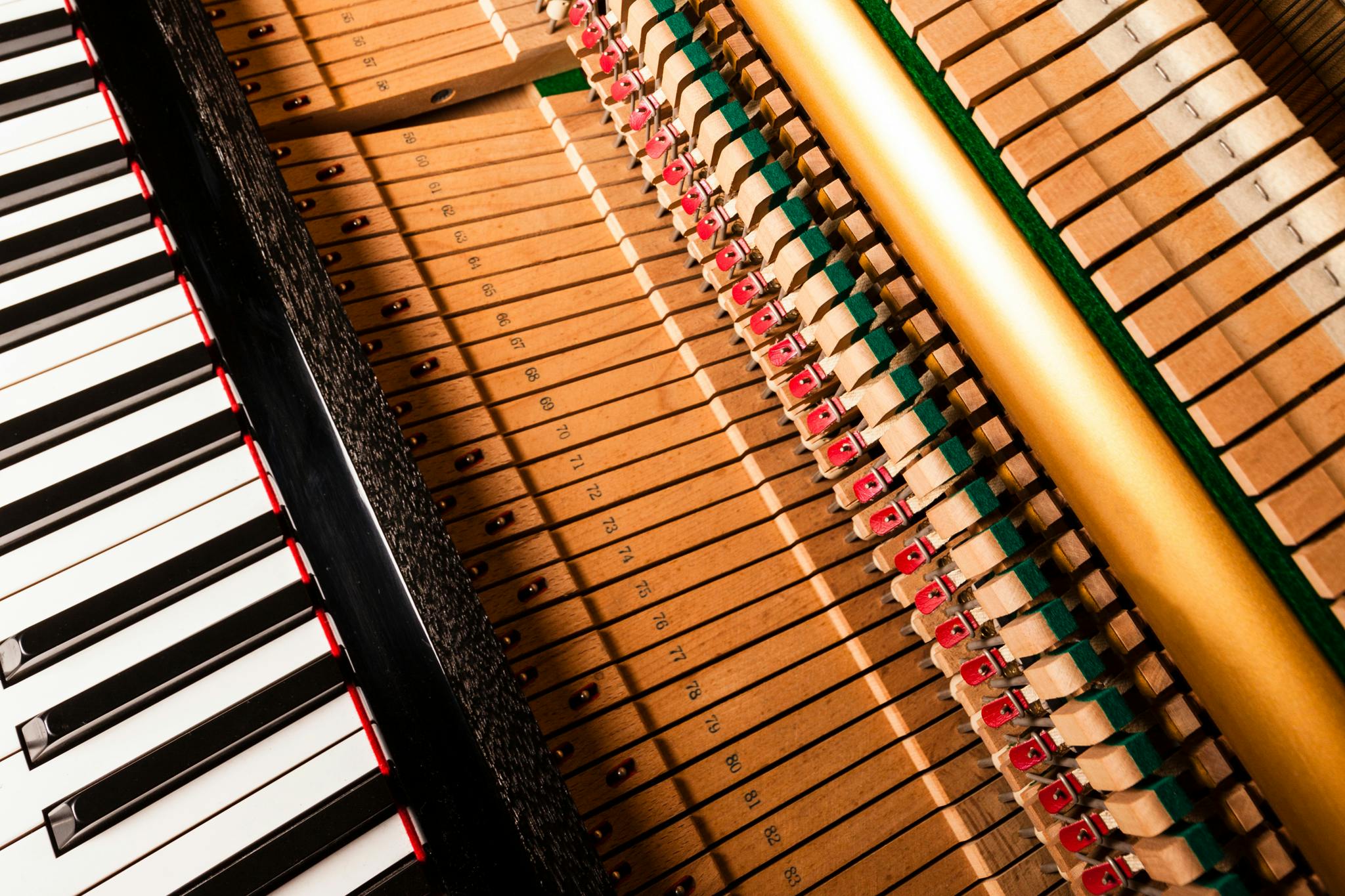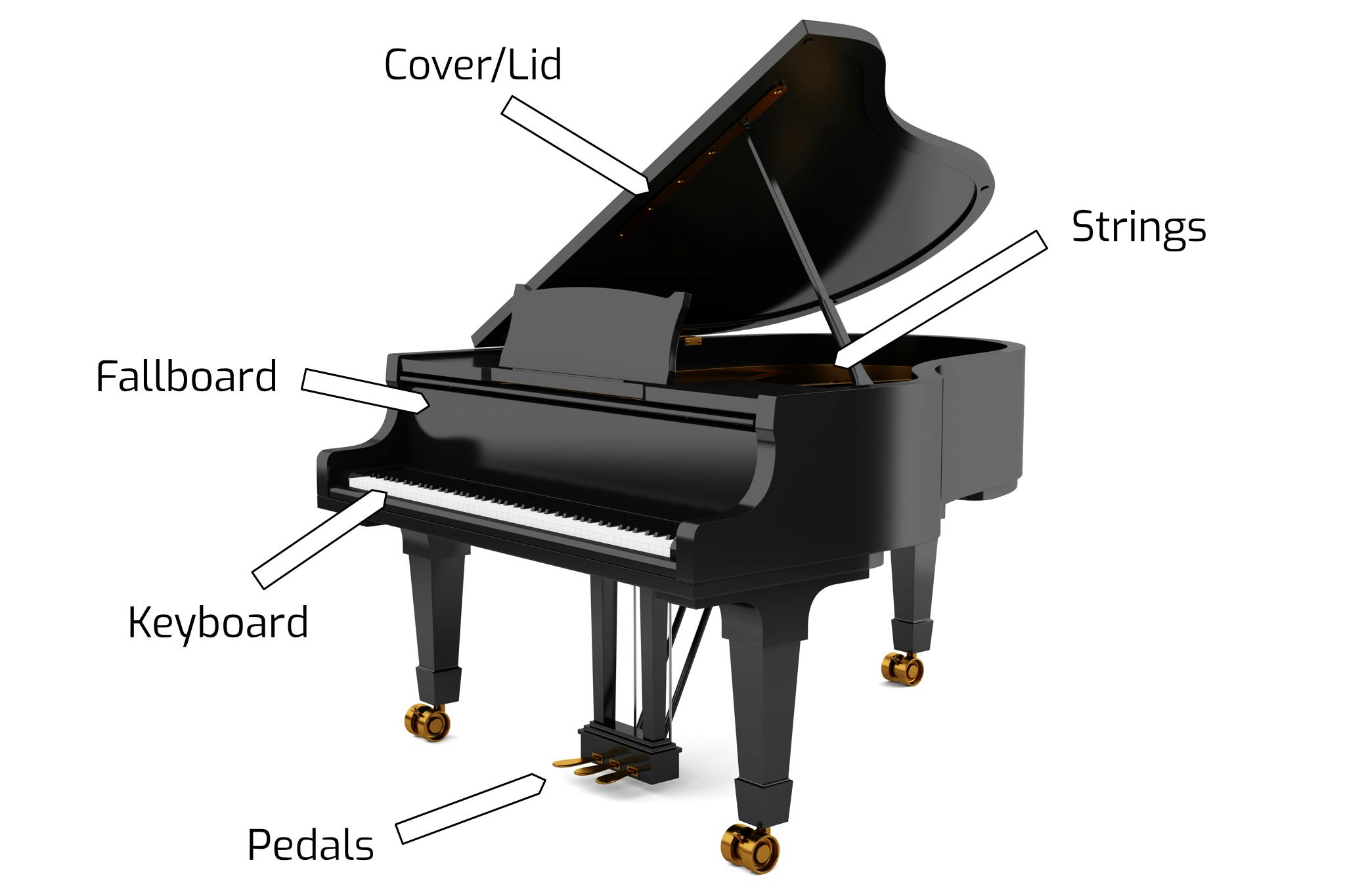
Learn the Anatomy of the Piano
A Little History
Keyboard instruments have been in existence in one shape or form for more than two thousand years, beginning with a type of pipe organ called a hydraulis. Whilst organs evolved over the next millennia, nothing much changed for keyboard instruments until the 14th century when the harpsichord and clavichord, both string instruments, were invented. They both involved use of a complex mechanism known as the action which converts the motion of a key being pressed into the interaction with the strings. The harpsichord works by plucking the strings mechanically with a plectrum when a key is pressed. However, this doesn't allow for dynamic playing as the volume is more or less consistent regardless of how hard you hit the key. In contrast, the clavichord works by striking the strings with a metal blade called a tangent, which does allow for dynamic playing but the key must remain pressed to sustain the played note.
By the late 17th / early 18th century a musical instrument maker named Bartolomeo Cristofori invented the first pianoforte. Its unique action involved striking the strings with a hammer when the key was pressed, but then immediately falling back away from the strings allowing them to continue vibrating. At least until the key was released at which point a damper would re-engage with the string to dampen it. This allowed for a much greater dynamic range than had been available before on a keyboard instrument. The name pianoforte literally translates to soft (piano) and loud (forte) which expressed this dynamic range. The name was later commonly shortened to just piano.
A little later Gottfried Silbermann, another keyboard instrument maker, invented what would later become the sustain pedal, albeit his was operated by hand. When engaged, this would lift the dampers on all strings allowing single notes and chords to be sustained after the keys were released.
Acoustic Piano
As a descendant of the early pianos mentioned above, the traditional piano is still played acoustically by pressing a key on the keyboard, which in turn causes a hammer to strike the strings. It is also worth noting that pianos normally have 1 to 2 strings per note for the bass and 3 strings each for the tenor and treble notes. You might then think that this makes the piano a string instrument, like a violin or a guitar. Not so fast! Because the action involves striking the string rather than plucking it like the harpsichord or guitar, or bowing it like a violin, it can also be classified as a percussion instrument. This debate has persisted for a very long time so let's just say that the piano is both a string and percussion instrument and move on.

There are a variety of different acoustic piano styles available, but the most commonly seen are the upright piano and the grand piano. The main difference being the orientation of the strings, vertical in an upright and horizontal in a grand. There is also the small matter of price with grand pianos generally being considerably more expensive than their upright alternatives. Both styles come in different sizes but generally they have the same size 88 key keyboard, 52 white natural keys and 36 black sharp/flat keys.

Most pianos will also include 3 foot operated pedals (although some only provide 2). The left soft pedal internally moves the position of the hammers slightly so that only 2 of the 3 strings are struck creating a softer sound. The right sustain pedal, the most commonly used, lifts the dampers on all strings at the same time allowing notes to continue ringing out after the keys are released. This includes other strings which have not been played but vibrate sympathetically. The purpose of the middle pedal differs with the type of piano. Typically on a grand piano this is called the sostenuto pedal which, when pressed, will keep only the currently lifted dampers raised (unlike the sustain pedal which raises all dampers). However on an upright piano the middle pedal is more commonly called the practice pedal as it dampens all the strings, only allowing a muted sound. This can also normally be locked in position with a sideways movement.
Digital Piano
Since the 1930's the piano has experienced several periods of innovation, starting out with electric pianos that used magnetic pickups to convert the string vibrations into electrical signals that could be amplified and played through a speaker. In the 60's and 70's there was further innovation with the likes of the Fender Rhodes which replaced strings with metal tines (think similar to a pitch tuning fork). They still required hammers to strike them and magnetic pickups to convert to an electrical signal that could be amplified. The first analog synthesizers were also produced during this period which could control pitch by manipulating oscillating frequencies with changes to the electrical voltage.

By the 1980's, with the reduced costs of mass manufactured micro processors, we were thrust forward into the digital age. Digital synthesizers were all the rage, able to reasonably emulate the sounds of other pianos but also create a plethora of their own new sounds. As technology continued to evolve, so did digital sampling. Which brings us to modern day digital pianos and midi controllers (a keyboard with no built in sounds of its own so needs to be hooked up to a computer) that are able to replicate, via digital samples of the original instrument, the sound of any acoustic, electric or electronic piano. Some to the extent that a blindfolded listener may not be able to tell the difference between the original instrument and its digital counterpart.

Digital pianos come in a variety of styles and sizes. They don't have the same space requirements for strings and complex actions as their acoustic cousins. Some are only a little bigger than the keyboard itself and can be placed on a desk or stand. Others replicate the look and feel of a traditional upright piano. Which to get really depends on your needs. Do you need it to be portable? For example carrying it to gigs (or just packing away when not used)? Or will it have a dedicated spot in the house? Other advantages of a digital piano include direct recording to your computer without the need for setting up microphones, updating of software and virtual instruments to add new sounds, being able to only listen on headphones so as not to disturb others.
The Keyboard
You may have noticed that a piano keyboard consists of a repeating pattern of 12 keys, 7 white and 5 black. The white keys are known as natural keys and the black as sharp/flat keys. These twelve keys together make up an octave. Interestingly before the 19th century all the natural keys were black and the sharp/flat keys white. It isn't known for sure why they were reversed but some speculate it was for the improved visual separation between the now white keys due to the dark gaps between them.
A typical modern piano has 88 keys which is made up of 7 full octaves plus an additional 3 keys at the starting bass end and 1 at the treble end. You can buy smaller keyboards of course, especially of the MIDI Controller type which can have as few as 25 keys. In order to identify which octave is which (imagine being asked to play C, which C do you choose?), each octave has a registry range number. The first C on the piano begins with registry range 1 through to the B of that octave. The next C begins registry range 2, and so on. Normally this is shown with the pitch class / note followed by the range number, so C1 for example. Now remember there were 3 keys added to the beginning of the keyboard. This means the typical piano keyboard starts with A0 at one end through to C8 at the other. You may have heard the term middle C before? This refers to C in the 4th register so is written as C4.
If you are completely new to some of the terms we have just used, or maybe wondering why we start from C and not A, or maybe you just feel a little rusty, why not check out our free Fundamentals of Music Theory course.







